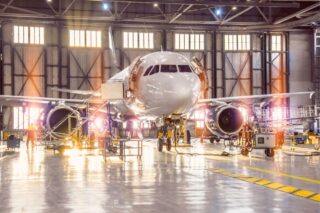On the occasion of the 20th anniversary of our publisher, the industry sourcing company DirectIndustry, we are celebrating 20 years of industrial innovations by giving the floor to the players that brought these innovations to life. In this interview, we focus on collaborative robots. Esben Hallundbæk Østergaard, co-founder of Universal Robots, gives his insights into 20 years of innovations in robotics, including the birth of cobotics, which his company very much encouraged.
20 Years of ROBOTICS with… Universal Robots
Universal Robots is a Danish robot manufacturer founded in 2005 by three engineers, Esben Østergaard, Kasper Støy, and Kristian Kassow. Their idea was to make robots flexible, easy to use and small like a tool. While the market was mainly dominated by heavy and unwieldy industrial robots operating behind fences, UR targeted small and medium-sized businesses and developed collaborative arms for them that can safely work with people, cage-free. Cobotics was born.
DirectIndustry magazine: We can easily affirm that UR is at the origin of the cobotics revolution of the last few years. How did you know when you started UR that you were being disruptive and basically creating a new market?
Esben Østergaard: We knew there was a market for this kind of robot from the beginning. Our idea, back in 2003, was basically to solve a problem for the Danish food industry. There were two food companies, one was making cakes and the other one frozen pizzas. They had small volumes but wanted to make different kinds of cakes and different kinds of pizzas on the same production line. We tried to implement traditional robots in this environment and realized it did not work. Those robots were not flexible enough and because we could not use outsider system integrators, we could not make the required adjustments to the robots that would allow them to make the different kinds of cakes and of pizzas. So we thought about making a robot, more like a tool, to help people on the factory floor. In 2005, we started Universal Robots to make these flexible robots. We started with the food industry but we soon saw the potential was elsewhere. A number of manufacturing industries in Europe could benefit from this technology.

DirectIndustry magazine: Did you intend to make “cobots” when you started UR or was it just another type of robot? Your company is called Universal Robots and not Universal Cobots.
E.Ø.: Making “cobots” was not what we intended to make when we started UR. It is the general term on the market today, but UR did not invent the term “cobots”. We just invented the market. When talking about cobots, people only think about the safety aspects of the robots. In some sense, this is true, as collaborative robots meet the safety standards. But it is not the safety standards that made them popular. It was UR that made them popular when we made flexible and redeployable robots. Safety is a part of that, of course. But a “cobot” is mainly a tool that helps people do their job, more than a machine that steals jobs. UR is about easy flexible automation.
DirectIndustry magazine: What is or has been the impact of cobotics on the robotic sector?
E.Ø.: I think the potential for cobots is today much bigger than for traditional industrial robots. Cobots are also shifting the focus of industry in general. Traditional robots do the same tasks over and over again. They are very good at high volume manufacturing like cars. This is why cars are so cheap and everybody can afford to buy one. The future value is probably around more unique products. Cobots enable shorter production batches. And they also allow you to produce not only in low-wage countries but also in high-wage countries, which means you can produce closer to the consumers, which means that the time to market can become shorter. You can also have more of the consumer needs built into the products. You can have more material experts, designers, consumer experts near or on the factory floor to produce the kind of value that the consumer wants. That means you can increase the value of your factory.

DirectIndustry magazine: The big disruption was also the price of the robots. Cobots are cheaper.
E.Ø.: The interesting thing is that cobots are not cheaper in terms of technology because they have more things built into them. The robot itself has the safety system which is costly, the controller of the robot is actually more expensive than for the more traditional robots. It’s not the technology that is cheaper, but the application of the robot. A collaborative robot is easy and cheaper to deploy and redeploy, it’s easy to adjust the program, you can put it on a table, you don’t need a cage. So all this decreases the installation cost. So it is a myth that the cobot is cheaper, it is actually the use of it that makes it cheaper.
DirectIndustry magazine: 20 years ago, what could a robot not do that it can now? And what can it still not do?
E.Ø.: There are still many things robots cannot do. I think 20 years ago, people were expecting robot butlers and today we’re still not there. Self-driving cars have also been predicted for a long time and we’re not there. And generally robots moving around people are still not really there. On the other hand, cobots are an example of robots moving out of the cage into human lines, in a free environment without controls. We’ve also started seeing robots in hospitals. But it is a slower process than we had envisioned 20 years ago.

DirectIndustry magazine: What are the other revolutions in robotics in the last 20 years?
E.Ø.: There has been a slow growth and a lot of disappointments. But today is a good time, things are changing, people are getting older, it is difficult to find labor in some countries, salaries are high, technology has become cheaper and can do many more things. It is the time now to start the next wave of the robotics revolution. I think the potential for robotics is bigger than for the IT industry. In the last 4 years, the IT industry has been predominant with the largest companies being IT companies. I think robotics companies will have a similar evolution. Sensors are something that is really moving this year. And it will lead to new types of applications.
DirectIndustry magazine: How do you envision the next 20 years?
E.Ø.: The future I see is not a factory full of robots and no humans. I see a factory where robots and humans work alongside each other. Craftsmen, designers and robots all working together in the same factory to produce the unique products consumers want. I see a mix of handicraft and manufacturing. No one really wants to work like a robot so all the repetitive and hard tasks that can be automated will be increasingly automated in the future and done by robots. New jobs are coming.












